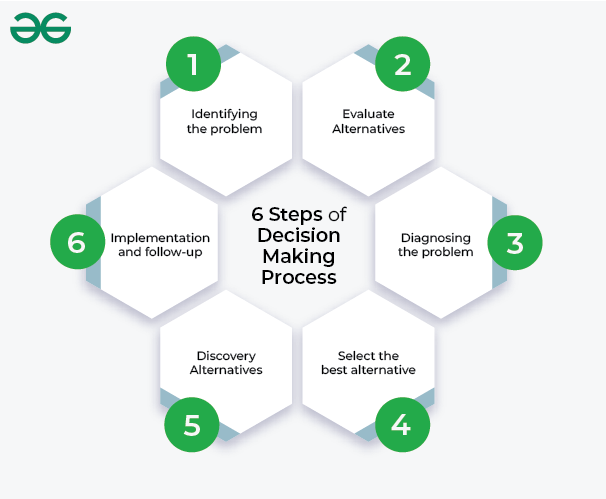6 Steps of Decision-making Process
Last Updated :
18 Oct, 2023
Decision-making is the process of selecting the best course of action from a set of alternative options to achieve a desired goal or objective. It involves four interrelated phases: explorative (searching for potential alternatives), speculative (identifying the factors that influence the decision problem), evaluative (analyzing and comparing the alternative courses of action), and selective (making the final choice of the best course of action). The ultimate aim of decision-making is to find the option that is believed to fulfil the objective of the decision problem most satisfactorily compared to other alternatives.

6 Steps of Decision-making Process
Decision-making is a systematic process that comprises the following elements:
- Identifying the Problem: The decision-making process begins by recognizing a problem that requires resolution. This problem may arise due to a gap between the present state and the desired state of affairs or as a result of environmental changes presenting threats or opportunities. Managers need to continuously monitor the situation to swiftly identify and define the real problem. Properly defining the problem is crucial for a clear decision-making environment, and it requires imagination, experience, and judgment to detect managerial decision needs effectively.
- Diagnosing the Problem: Diagnosing the real problem involves analyzing its elements, magnitude, urgency, course, and its relation with other problems. Managers must gather all relevant facts and analyze them carefully to diagnose the problem accurately. The critical aspect of problem diagnosis is determining the actual causes or sources of the problem, ensuring that symptoms are not mistaken for the real issue. For instance, addressing manufacturing costs may not solve the problem if the real issue lies in poor engineering design. The problem can be analyzed based on its nature (routine or strategic), impact, futurity, periodicity, and relevant limiting or strategic factors.
- Discovery Alternatives: The next step in the decision-making process is to explore various possible alternatives. Rushing to adopt the first feasible solution is not advisable for executives. Identifying available courses of action may not always be apparent, and decision-makers must employ their ingenuity and creativity to recognize and relate them. Having a reasonably wide range of alternatives grants managers more freedom in their choices. However, it is prudent for management to focus on discovering critical or strategic alternatives relevant to the problem at hand, following the principle of the limiting factor. Strategic factors are those that hold the most significance in determining the appropriate action for a given problem. For instance, when deciding on expanding operations, capital availability or government regulations may act as limiting factors. Selecting the most favorable alternative involves recognizing and resolving these critical factors to achieve desired goals accurately. The goal is to keep the number of alternatives manageable while considering time and cost constraints. Developing alternatives is a creative process that necessitates research and imagination. Management must ensure thorough consideration of the best alternatives before finalizing a course of action, gathering and analyzing relevant information for this purpose.
- Evaluate Alternatives: After discovering the alternatives, the next step is to evaluate them. This process involves measuring the positive and negative consequences of each option, considering costs and benefits. Judgement and knowledge are vital in assessing the net benefit of each alternative. Both quantitative and qualitative factors should be taken into account, including risk, available resources, and timing. Management should establish evaluation criteria to weigh the options effectively, considering factors like risk, economy of effort, timing, and limitation of resources within the organisation.
- Select the Best Alternative: After evaluating the alternatives, the optimal choice is selected. The optimum alternative maximizes results under the given conditions. This step is crucial in decision-making and sets successful managers apart from unsuccessful ones. Past experience, experimentation, research, and analysis contribute to selecting the best alternative.
- Implementation and Follow-up: After making a decision, the implementation process begins with communication and obtaining feedback. Procedures, time frames, and necessary resources are established for implementation. Continuous monitoring ensures progress and desired outcomes. Responsibility for specific tasks is assigned to individuals if needed. Periodic progress reports help in assessing the decision’s effectiveness. Herbert Simon’s decision-making process includes three phases: intelligence activity (identifying and diagnosing the problem, defining objectives, and collecting information), decision activity (generating and evaluating alternatives), and choice activity (selecting the best course of action, followed by implementation).
Share your thoughts in the comments
Please Login to comment...